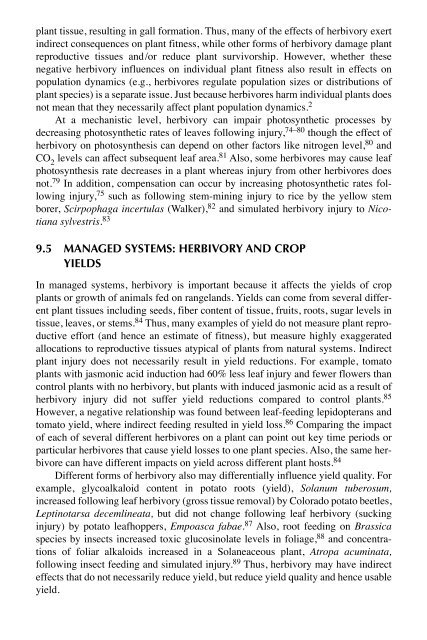Biotic Stress and Yield Loss
Biotic Stress and Yield Loss
Biotic Stress and Yield Loss
- No tags were found...
Create successful ePaper yourself
Turn your PDF publications into a flip-book with our unique Google optimized e-Paper software.
plant tissue, resulting in gall formation. Thus, many of the effects of herbivory exertindirect consequences on plant fitness, while other forms of herbivory damage plantreproductive tissues <strong>and</strong>/or reduce plant survivorship. However, whether thesenegative herbivory influences on individual plant fitness also result in effects onpopulation dynamics (e.g., herbivores regulate population sizes or distributions ofplant species) is a separate issue. Just because herbivores harm individual plants doesnot mean that they necessarily affect plant population dynamics. 2At a mechanistic level, herbivory can impair photosynthetic processes bydecreasing photosynthetic rates of leaves following injury, 74–80 though the effect ofherbivory on photosynthesis can depend on other factors like nitrogen level, 80 <strong>and</strong>CO 2levels can affect subsequent leaf area. 81 Also, some herbivores may cause leafphotosynthesis rate decreases in a plant whereas injury from other herbivores doesnot. 79 In addition, compensation can occur by increasing photosynthetic rates followinginjury, 75 such as following stem-mining injury to rice by the yellow stemborer, Scirpophaga incertulas (Walker), 82 <strong>and</strong> simulated herbivory injury to Nicotianasylvestris. 839.5 MANAGED SYSTEMS: HERBIVORY AND CROPYIELDSIn managed systems, herbivory is important because it affects the yields of cropplants or growth of animals fed on rangel<strong>and</strong>s. <strong>Yield</strong>s can come from several differentplant tissues including seeds, fiber content of tissue, fruits, roots, sugar levels intissue, leaves, or stems. 84 Thus, many examples of yield do not measure plant reproductiveeffort (<strong>and</strong> hence an estimate of fitness), but measure highly exaggeratedallocations to reproductive tissues atypical of plants from natural systems. Indirectplant injury does not necessarily result in yield reductions. For example, tomatoplants with jasmonic acid induction had 60% less leaf injury <strong>and</strong> fewer flowers thancontrol plants with no herbivory, but plants with induced jasmonic acid as a result ofherbivory injury did not suffer yield reductions compared to control plants. 85However, a negative relationship was found between leaf-feeding lepidopterans <strong>and</strong>tomato yield, where indirect feeding resulted in yield loss. 86 Comparing the impactof each of several different herbivores on a plant can point out key time periods orparticular herbivores that cause yield losses to one plant species. Also, the same herbivorecan have different impacts on yield across different plant hosts. 84Different forms of herbivory also may differentially influence yield quality. Forexample, glycoalkaloid content in potato roots (yield), Solanum tuberosum,increased following leaf herbivory (gross tissue removal) by Colorado potato beetles,Leptinotarsa decemlineata, but did not change following leaf herbivory (suckinginjury) by potato leafhoppers, Empoasca fabae. 87 Also, root feeding on Brassicaspecies by insects increased toxic glucosinolate levels in foliage, 88 <strong>and</strong> concentrationsof foliar alkaloids increased in a Solaneaceous plant, Atropa acuminata,following insect feeding <strong>and</strong> simulated injury. 89 Thus, herbivory may have indirecteffects that do not necessarily reduce yield, but reduce yield quality <strong>and</strong> hence usableyield.

















